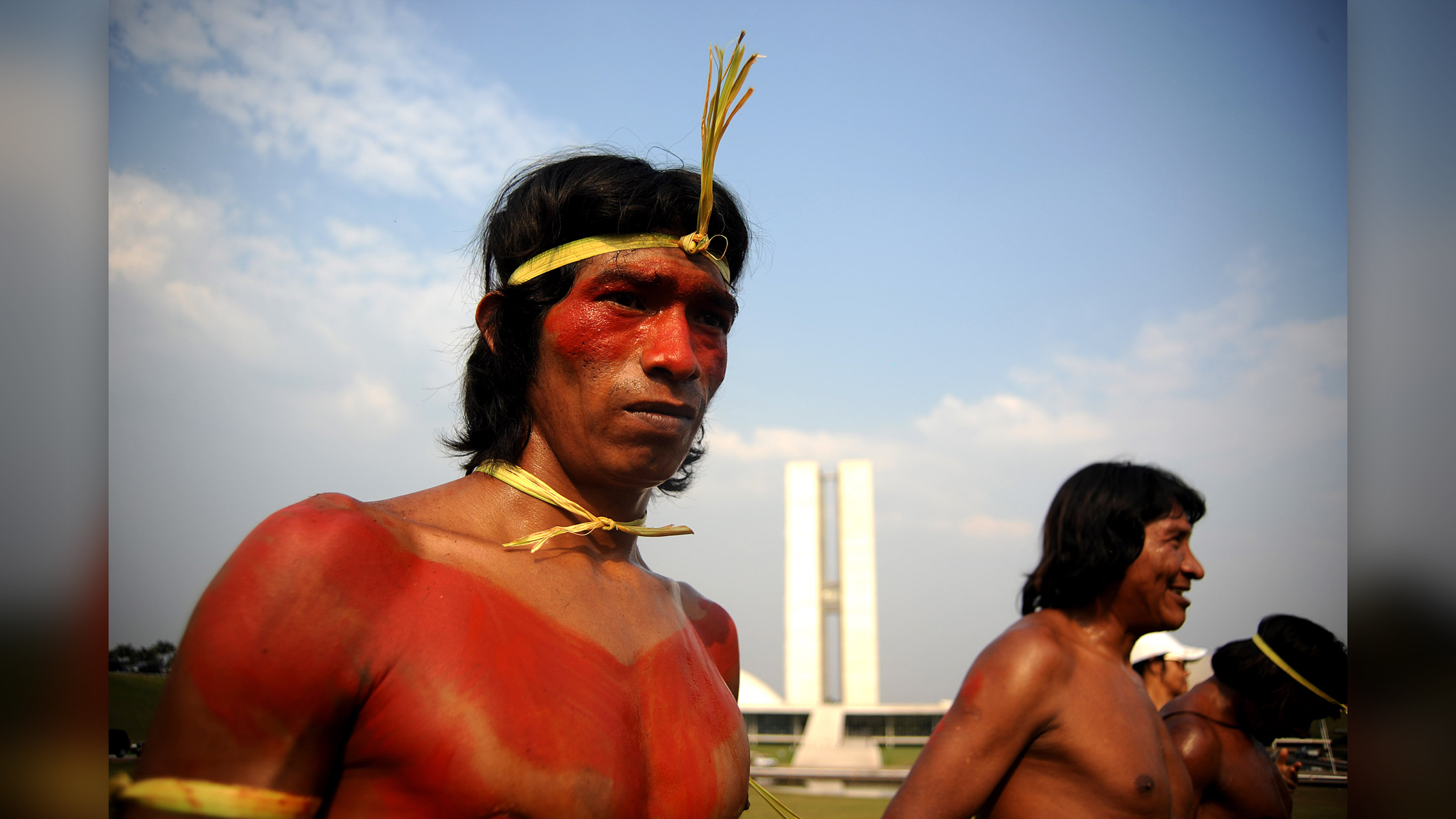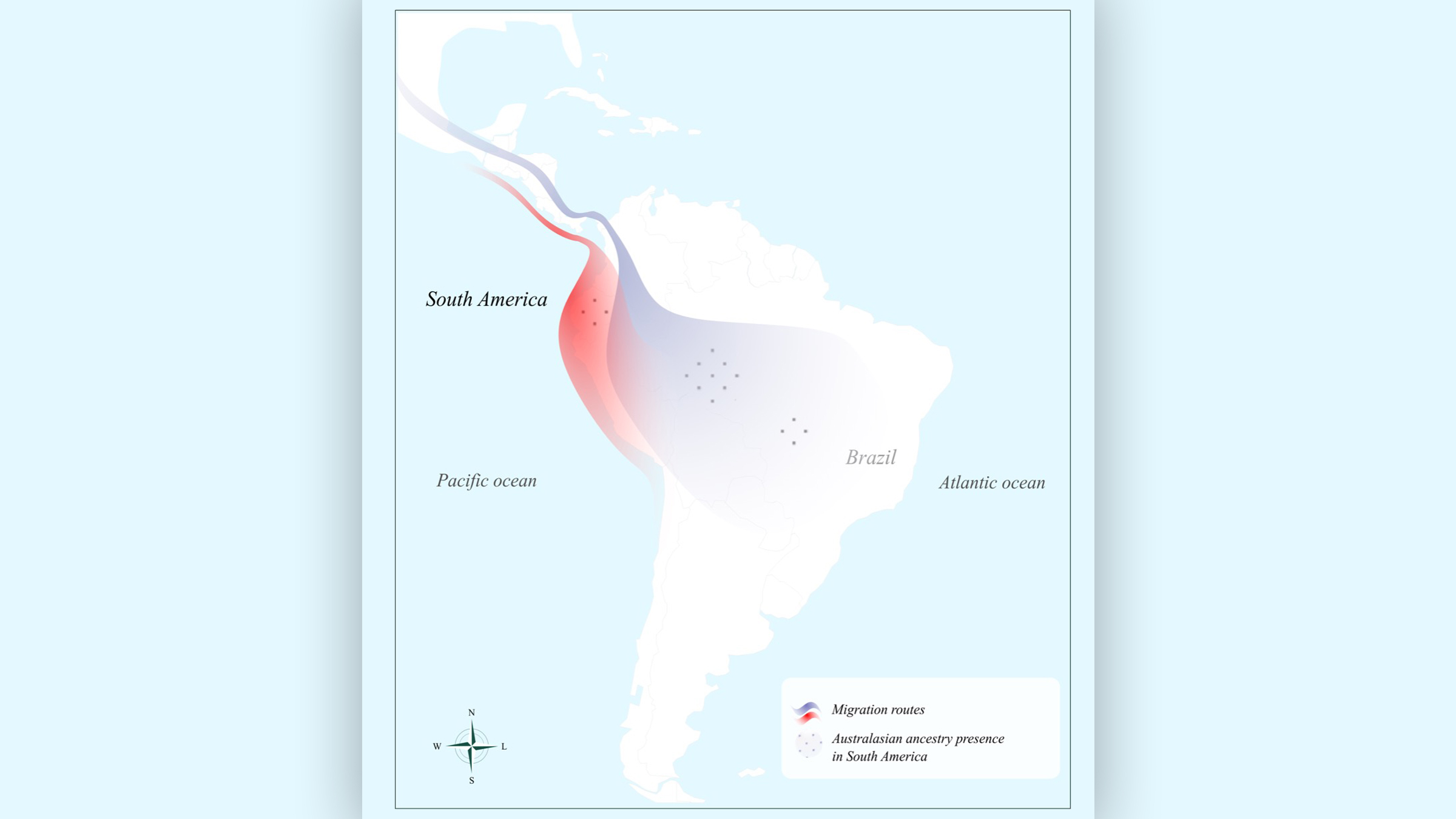1st Americans had Indigenous Australian genes
Indigenous South Americans share DNA with Indigenous people in Oceana.

During the last ice age, when hunters and gatherers crossed the ancient Bering Land Bridge that connected Asia with North America, they carried something special with them in their genetic code: pieces of ancestral Australian DNA, a new study finds.
Over the generations, these people and their descendants trekked southward, making their way to South America. Even now, more than 15,000 years after these people crossed the Bering Land Bridge, their descendants — who still carry ancestral Australian genetic signatures — can be found in parts of the South American Pacific coast and in the Amazon, the researchers found.
"Much of this history has unfortunately been erased by the colonization process, but genetics is an ally to unravel unrecorded histories and populations," study senior researcher and professor Tábita Hünemeier and study co-lead researcher and doctoral student Marcos Araújo Castro e Silva, both of whom are in the Department of Genetics and Evolutionary Biology at the University of São Paulo in Brazil, told Live Science in an email.
Related: 10 things we learned about our human ancestors in 2020
The new research builds on earlier work, first published in 2015, which showed that ancient and modern Indigenous people in the Amazon shared specific genetic signatures — known as the Ypikuéra, or Y signal — with modern-day Indigenous groups in South Asia, Australia and Melanesia, a group of islands in Oceania.
This genetic connection caught many scientists off guard, and it remains "one of the most intriguing and poorly understood events in human history," the researchers wrote in the new study.
To investigate the Y signal further, a team of scientists in Brazil and Spain dove into a large dataset containing the genetic data of 383 Indigenous people from different parts of South America. The team applied statistical methods to test whether any of the Native American populations had "excess" genetic similarity with a group they called the Australasians, or Indigenous peoples from Australia, Melanesia, New Guinea and the Andaman Islands in the Indian Ocean.
Sign up for the Live Science daily newsletter now
Get the world’s most fascinating discoveries delivered straight to your inbox.
In other words, the team was assessing whether "a given Native American population shared significantly more genetic variants with Australasians than other Native Americans do," Hünemeier and Araújo Castro e Silva said. South American groups that did have more genetic similarities with Australasians were interpreted by the new researchers as being descendants of the first Americans and Australasian ancestors, who coupled together at least 15,000 years ago.

As expected, the study confirmed the previous findings of Australasian genetic ties with the Karitiana and Suruí, Indigenous peoples in the Amazon. But the new genetic analysis also revealed a big surprise: The Australasian connection was also found in Peru's Chotuna people, an Indigenous group with ancestral ties to the Pacific Coast; the Guaraní Kaiowá, a group in central west Brazil; and the Xavánte, a group on the central Brazilian Plateau.
When the team looked specifically at the Chotuna people and other coastal Indigenous peoples, including the Sechura and Narihuala, the researchers found that these peoples had ancestry from a mix of South American people and a sister branch of the Onge, Indigenous people who live on Little Andaman island. When the team included the Xavánte people in the analysis, the model suggested that the coastal groups got started first, and later gave rise to the inland Amazonian groups with Australasian heritage.
The first settlers likely "stuck to the Pacific coast due to their subsistence strategies and other cultural aspects adapted to life by the sea," Hünemeier and Araújo Castro e Silva wrote in the email. "For this reason, they would have at least initially only expanded through and settled the whole American Pacific coast from Alaska until southern Chile. In this context, the expansion to the Amazon, passing through the northern Andes, would have been a secondary movement."
Related: The 25 most mysterious archaeological finds on Earth
According to archaeological records, a settlement on the Pacific coast dates to about 13,000 years ago, the researchers said. This jibes with the time frame the team suggested for the initial migration and the later inland coupling events in South America, which likely happened between 15,000 and 8,000 years ago, respectively, they said. Furthermore, while previous research suggested that there were two waves of first Americans who left Beringia about 15,000 years ago, and likely several waves from Beringia after that, the new study found that "one of the waves that came by the Pacific route was composed by individuals carrying some Australasian ancestry," Hünemeier and Araújo Castro e Silva said.
"This study is a welcome addition to prior literature, which had described signals of Australasian (southern Asian) ancestry in Amazonian groups," Alexander Ioannidis, an adjunct lecturer in computational engineering and researcher in biomedical data science at Stanford University, who led a 2020 study in the journal Nature about Polynesian ancestry, told Live Science in an email. Ioannidis wasn't involved in the new study.
As to why the Y signal isn't found in North American Indigenous peoples, the "authors suggest that if such a migration had traveled rapidly along the Pacific coast of North America into Central and then South America, then it could explain why the signal is present predominantly in South America (both on the Pacific coast and in the Amazon), but not in North American Indigenous groups," Ioannidis said. Or, perhaps Indigenous people in North and Central America who had the Y signal were wiped out during Europe's colonization of the New World, Hünemeier and Araújo Castro e Silva said.
How did they get there?
The researchers acknowledged that news of the Australasian-South American connection might spark ideas of an ancient sea voyage in the public's imagination. But the genetic model the team developed shows no evidence of an ancient boating expedition between South America and Australia and the surrounding islands at that time, the researchers said. Rather, the team emphasized, this ancestry came from people who crossed the Bering Land Bridge, probably from ancient coupling events between the ancestors of the first Americans and the ancestors of the Australasians "in Beringia, or even in Siberia as new evidence suggests," Hünemeier and Araújo Castro e Silva told Live Science.
"What likely happened is that some individuals from the extreme southeastern region of Asia, that later originated the Oceanic populations, migrated to northeast Asia, and there had some contact with ancient Siberian and Beringians," Araújo Castro e Silva said.
Put another way, the Australasians' ancestors coupled with the first Americans long before their descendants reached South America, the researchers said. "It is as if these genes had hitched a ride on the First American genomes," Hünemeier and Araújo Castro e Silva said.
The study will be published in the April 6 issue of the journal the Proceedings of the National Academy of Sciences.
Originally published on Live Science.

Laura is the archaeology and Life's Little Mysteries editor at Live Science. She also reports on general science, including paleontology. Her work has appeared in The New York Times, Scholastic, Popular Science and Spectrum, a site on autism research. She has won multiple awards from the Society of Professional Journalists and the Washington Newspaper Publishers Association for her reporting at a weekly newspaper near Seattle. Laura holds a bachelor's degree in English literature and psychology from Washington University in St. Louis and a master's degree in science writing from NYU.









